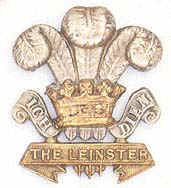Regimental Association of the Prince of Wales's Leinster Regiment (Royal Canadians)
|
|

Page 2 - 3rd Europeans
|
Regimental Association of the Prince of Wales's Leinster Regiment (Royal Canadians)
Page 2 - 3rd Europeans |
|
|
History of the 109th Regiment of Foot, 2nd Battalion the Prince of Wales's Leinster Regiment. 3rd Bombay European RegimentHaving been successful with the capture of Garrakota, the 3rd Bombay European Regiment returned to rejoin the 2nd Brigade at Saugor, there to recuperate before the next phase of the progress toward the 'rebel' stronghold Jhansi. During this 'R&R' period the 3rd Bombay European Regiment were permitted to experiment with a new battle uniform to replace the traditional heavy red and blue uniform worn by troops in England and the world over, wherever British forces were present. This new battle uniform was developed by the Regiment itself to create stone coloured cotton shirts and trousers. This was possibly the first time any British unit was permitted to wear a 'khaki' uniform. The experiment was deemed to have worked as the 3rd Bombay European Regiment from thenceforth became known as the "Brassheads" in recognition of the ability of the Regiment's ability to withstand the high temperatures of India. Respite was however short and late February found the 3rd Bombay European Regiment once more moving north with the 2nd Brigade toward Jhansi. Three more obstacles faced the 2nd Brigade before Jhansi., these being the strongholds of Narut, Dhamoni and Mundinpur. The 3rd Bombay European Regiment drew the attack on Mundinpur where the 2nd Brigade came under heavy attack. Once more, the Regiment under the command of Lt. Col. Liddell took the fight to their opponents beating back their foes from the hills overlooking the pass of Mundinpur and taking control of the area with a casualty list of only four men of the 3rd Bombay European Regiment wounded. Following a brief respite the 2nd Brigade continued on their route to Banpore and thence to the River Betwa where they encamped in temperatures of 105 degrees Fahrenheit (43 degrees C) on the 17th March 1858. On the 21st March the 2nd Brigade, including the 3rd Bombay European Regiment were before the formidable city of Jhansi, the scene of the massacre of English families in June 1857. The defences of Jhansi and its fort were reported to look impregnable and the battle plan involved taking the city prior to an attack on the fort. Preparations for a bombardment took place during the 24th and 25th and the action commenced on the 25th March 1858. The 1st Brigade arrived at Jhansi on the 25th and their artillery added to the bombardment that lasted eight days. Progress was made with much of the defences of the city and the fort in poor shape as a result of the combined bombardment, but the logistics of battle were kicking in and the continued availability of ammunition was becoming critical. It was at this time that events looked as if they were conspiring against the Regiment when, on the 31st March, a superior force of 20,000 troops of their foe were reported to be making their way to attack the British and relieve the city. Next Page |
Send mail with questions or comments about this web site. to
|